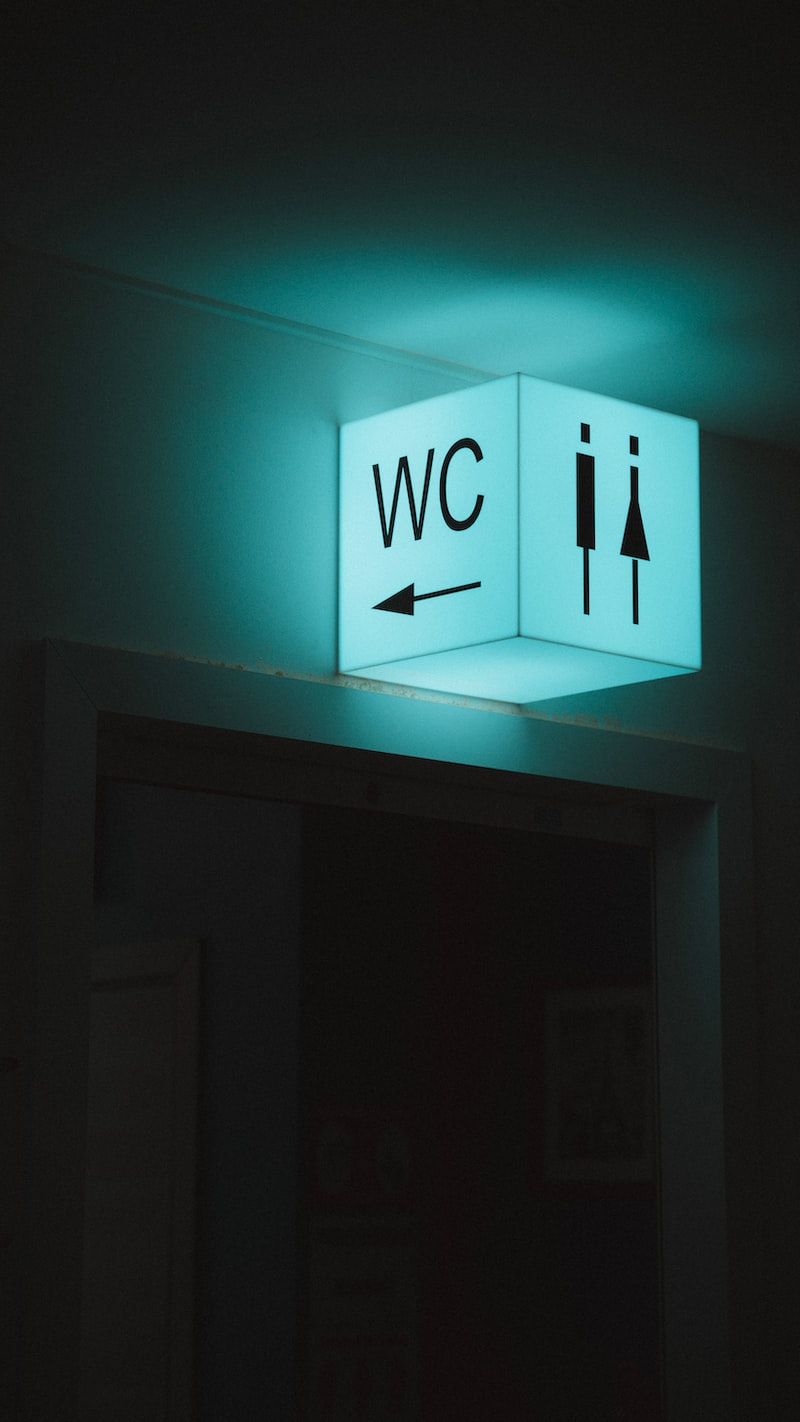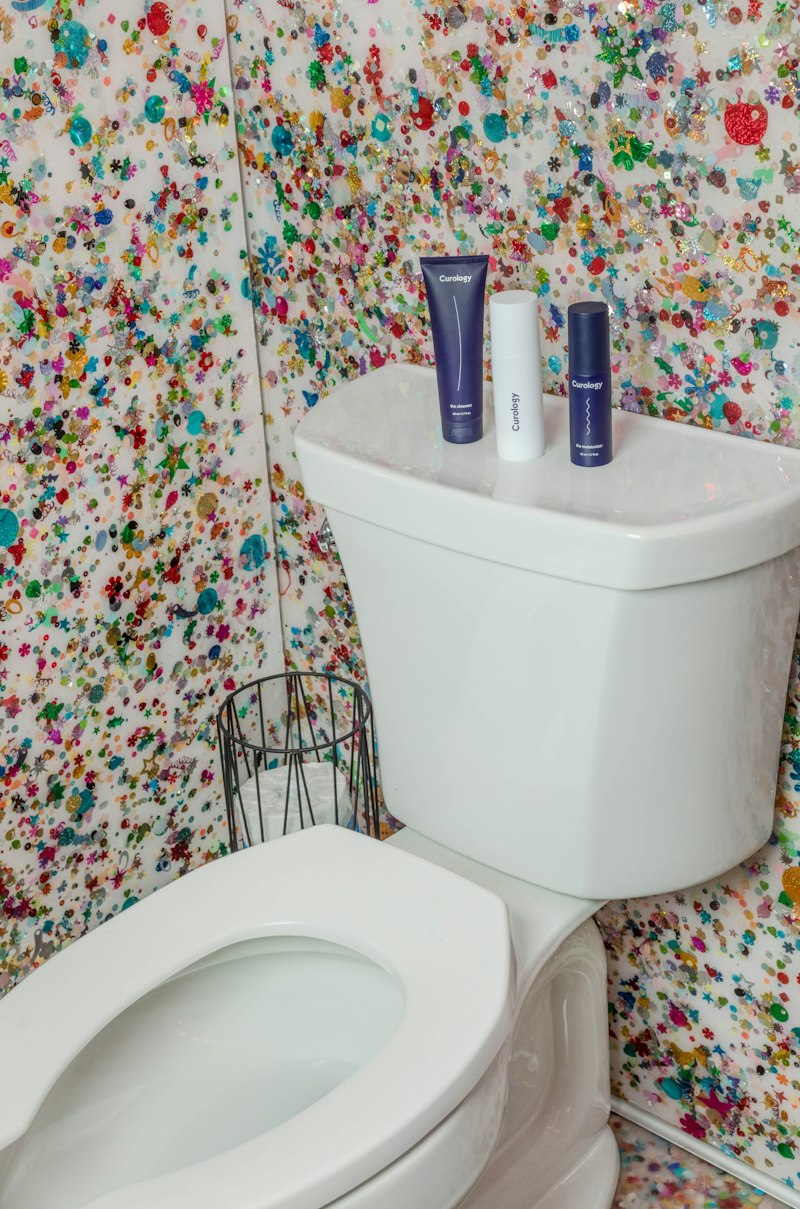Table of Contents
Have you ever wondered what happens in your toilet tank when you use bleach to clean it? Well, let’s dive into the fascinating world of the “bleach effect” and explore the impact it has on your porcelain throne.
When you pour bleach into your toilet tank, a chemical reaction is set in motion. The active ingredient in bleach, sodium hypochlorite, breaks down into its components: sodium ions and hypochlorous acid. These powerful substances work together to eliminate bacteria, germs, and stains in your toilet bowl, leaving it sparkling clean.
As the bleach solution enters the tank, it encounters any remaining water and begins to mix. The strong oxidizing properties of hypochlorous acid kick in, attacking and annihilating any organic matter present. This includes bacteria, algae, and other microorganisms that may have taken residence in your toilet tank.
The bleach effect doesn’t stop there. It continues its magic by preventing the growth of new bacteria and algae. The powerful sanitizing properties of bleach help maintain a hygienic environment in your toilet tank, reducing the risk of odors and potential health hazards.
However, it’s essential to be cautious when using bleach in your toilet tank. While it effectively cleans and disinfects, using too much can be harmful. Excessive amounts of bleach can damage the rubber flapper and other components in the tank, leading to leaks and costly repairs. It’s best to follow the manufacturer’s instructions or seek professional advice on the appropriate amount to use.
Additionally, remember that bleach is a strong chemical and should be handled with care. Always wear protective gloves and ensure proper ventilation when using bleach in your toilet tank or anywhere else in your home.
the bleach effect in your toilet tank is a powerful process that eliminates bacteria, germs, and stains, ensuring a clean and hygienic environment. By understanding how bleach works and using it responsibly, you can keep your toilet sparkling and fresh without causing any harm. So, go ahead, embrace the bleach effect, and enjoy a pristine toilet experience!
From Magic Potion to Bathroom Science: Exploring the Fascinating World of Toilet Tank Bleach
![The Bleach Effect: What Happens in Your<script>
if (window.qmn_quiz_data === undefined) {
window.qmn_quiz_data = new Object();
}
</script><script>window.qmn_quiz_data["3"] = {"quiz_id":"3","quiz_name":"How Emotionally Mature You Really Are?","disable_answer":"0","ajax_show_correct":"0","progress_bar":"1","contact_info_location":"0","qpages":{"1":{"id":"1","quizID":"2","pagekey":"gcfoNOXd","hide_prevbtn":"0"},"2":{"id":"2","quizID":"2","pagekey":"EL8aKWca","hide_prevbtn":"0"},"3":{"id":"3","quizID":"3","pagekey":"fqHJbbwq","hide_prevbtn":"0"},"4":{"id":"4","quizID":"3","pagekey":"iE0FbZQN","hide_prevbtn":"0"},"5":{"id":"5","quizID":"3","pagekey":"gMsHEhcA","hide_prevbtn":"0"},"6":{"id":"6","quizID":"3","pagekey":"VzGvfTSM","hide_prevbtn":"0"},"7":{"id":"7","quizID":"3","pagekey":"E2PfH0n8","hide_prevbtn":"0"},"8":{"id":"8","quizID":"3","pagekey":"pUVCsQTx","hide_prevbtn":"0"},"9":{"id":"9","quizID":"3","pagekey":"YiINdASZ","hide_prevbtn":"0"}},"skip_validation_time_expire":"0","timer_limit_val":0,"disable_scroll_next_previous_click":"0","disable_first_page":"0","enable_result_after_timer_end":"0","enable_quick_result_mc":"0","end_quiz_if_wrong":0,"form_disable_autofill":"0","disable_mathjax":"0","enable_quick_correct_answer_info":"0","quick_result_correct_answer_text":"Correct! You have selected correct answer.","quick_result_wrong_answer_text":"Wrong! You have selected wrong answer.","quiz_processing_message":"","quiz_limit_choice":"Limit of choice is reached.","not_allow_after_expired_time":"","scheduled_time_end":false,"error_messages":{"email_error_text":"Not a valid e-mail address!","number_error_text":"This field must be a number!","incorrect_error_text":"The entered text is not correct!","empty_error_text":"Please complete all required fields!","url_error_text":"The entered URL is not valid!","minlength_error_text":"Required atleast %minlength% characters.","maxlength_error_text":"Maximum %maxlength% characters allowed."},"first_page":true}
</script><div class='qsm-quiz-container qsm-quiz-container-3 qmn_quiz_container mlw_qmn_quiz quiz_theme_default '>
<form name="quizForm3" id="quizForm3" action="/the-bleach-effect-what-happens-in-your-toilet-tank/" method="POST" class="qsm-quiz-form qmn_quiz_form mlw_quiz_form" novalidate enctype="multipart/form-data">
<input type="hidden" name="qsm_hidden_questions" id="qsm_hidden_questions" value="">
<input type="hidden" name="qsm_nonce" id="qsm_nonce_3" value="33efa0508a">
<input type="hidden" name="qsm_unique_key" id="qsm_unique_key_3" value="681566bbef3ea">
<div id="mlw_error_message" class="qsm-error-message qmn_error_message_section"></div>
<span id="mlw_top_of_quiz"></span>
<section class="qsm-page ">
<div class="quiz_section quiz_begin">
<div class='qsm-before-message mlw_qmn_message_before'>
<p><img class="wp-image-685 aligncenter" data-src="https://tipblogs.com/wp-content/uploads/quiz.jpg" alt="quiz" width="500" height="544" /></p>
</div>
</div>
</section>
<section class="qsm-page qsm-page-1"
data-pid="1" data-prevbtn="0" style='display: none;'>
<div class='quiz_section qsm-question-wrapper question-type-0 question-section-id-5 ' data-qid='5'>
<span class='mlw_qmn_question_number'>1. </span>
<div class='mlw_qmn_new_question'>What's your basic life philosophy? </div>
<div class='mlw_qmn_question qsm_remove_bold' >
<p></p>
</div>
<div class='qmn_radio_answers mlwRequiredRadio'>
<div class="qmn_mc_answer_wrap mrq_checkbox_class" id="question5-1 ">
<input type='radio' class='qmn_quiz_radio qmn-multiple-choice-input' name="question5" id="question5_1" value="0" />
<label class="qsm-input-label" for="question5_1">
Take time to appreciate the small joys </label>
</div>
<div class="qmn_mc_answer_wrap mrq_checkbox_class" id="question5-2 ">
<input type='radio' class='qmn_quiz_radio qmn-multiple-choice-input' name="question5" id="question5_2" value="1" />
<label class="qsm-input-label" for="question5_2">
I always see the cup as half full </label>
</div>
<div class="qmn_mc_answer_wrap mrq_checkbox_class" id="question5-3 ">
<input type='radio' class='qmn_quiz_radio qmn-multiple-choice-input' name="question5" id="question5_3" value="2" />
<label class="qsm-input-label" for="question5_3">
Diligence is the key to success </label>
</div>
<div class="qmn_mc_answer_wrap mrq_checkbox_class" id="question5-4 ">
<input type='radio' class='qmn_quiz_radio qmn-multiple-choice-input' name="question5" id="question5_4" value="3" />
<label class="qsm-input-label" for="question5_4">
I trust my instincts </label>
</div>
<input type="radio" style="display: none;" name="question5" id="question5_none" checked="checked" value="" />
</div>
</div>
</section>
<section class="qsm-page qsm-page-2"
data-pid="2" data-prevbtn="0" style='display: none;'>
<div class='quiz_section qsm-question-wrapper question-type-0 question-section-id-6 ' data-qid='6'>
<span class='mlw_qmn_question_number'>2. </span>
<div class='mlw_qmn_new_question'>Your Solo Time Activities </div>
<div class='mlw_qmn_question qsm_remove_bold' >
<p></p>
</div>
<div class='qmn_radio_answers mlwRequiredRadio'>
<div class="qmn_mc_answer_wrap mrq_checkbox_class" id="question6-1 ">
<input type='radio' class='qmn_quiz_radio qmn-multiple-choice-input' name="question6" id="question6_1" value="0" />
<label class="qsm-input-label" for="question6_1">
Immersing in a new book </label>
</div>
<div class="qmn_mc_answer_wrap mrq_checkbox_class" id="question6-2 ">
<input type='radio' class='qmn_quiz_radio qmn-multiple-choice-input' name="question6" id="question6_2" value="1" />
<label class="qsm-input-label" for="question6_2">
Sketching out a foreign travel itinerary </label>
</div>
<div class="qmn_mc_answer_wrap mrq_checkbox_class" id="question6-3 ">
<input type='radio' class='qmn_quiz_radio qmn-multiple-choice-input' name="question6" id="question6_3" value="2" />
<label class="qsm-input-label" for="question6_3">
Catching up on series or watching a movie </label>
</div>
<div class="qmn_mc_answer_wrap mrq_checkbox_class" id="question6-4 ">
<input type='radio' class='qmn_quiz_radio qmn-multiple-choice-input' name="question6" id="question6_4" value="3" />
<label class="qsm-input-label" for="question6_4">
Alone time? My schedule's always full! </label>
</div>
<input type="radio" style="display: none;" name="question6" id="question6_none" checked="checked" value="" />
</div>
</div>
</section>
<section class="qsm-page qsm-page-3"
data-pid="3" data-prevbtn="0" style='display: none;'>
<div class='quiz_section qsm-question-wrapper question-type-0 question-section-id-7 ' data-qid='7'>
<span class='mlw_qmn_question_number'>3. </span>
<div class='mlw_qmn_new_question'>When You Feel Proudest </div>
<div class='mlw_qmn_question qsm_remove_bold' >
<p></p>
</div>
<div class='qmn_radio_answers mlwRequiredRadio'>
<div class="qmn_mc_answer_wrap mrq_checkbox_class" id="question7-1 ">
<input type='radio' class='qmn_quiz_radio qmn-multiple-choice-input' name="question7" id="question7_1" value="0" />
<label class="qsm-input-label" for="question7_1">
Cracking a tough problem </label>
</div>
<div class="qmn_mc_answer_wrap mrq_checkbox_class" id="question7-2 ">
<input type='radio' class='qmn_quiz_radio qmn-multiple-choice-input' name="question7" id="question7_2" value="1" />
<label class="qsm-input-label" for="question7_2">
Going the extra mile to assist someone </label>
</div>
<div class="qmn_mc_answer_wrap mrq_checkbox_class" id="question7-3 ">
<input type='radio' class='qmn_quiz_radio qmn-multiple-choice-input' name="question7" id="question7_3" value="2" />
<label class="qsm-input-label" for="question7_3">
Upholding my tranquility and boundaries </label>
</div>
<div class="qmn_mc_answer_wrap mrq_checkbox_class" id="question7-4 ">
<input type='radio' class='qmn_quiz_radio qmn-multiple-choice-input' name="question7" id="question7_4" value="3" />
<label class="qsm-input-label" for="question7_4">
Being acknowledged by someone I admire </label>
</div>
<input type="radio" style="display: none;" name="question7" id="question7_none" checked="checked" value="" />
</div>
</div>
</section>
<section class="qsm-page qsm-page-4"
data-pid="4" data-prevbtn="0" style='display: none;'>
<div class='quiz_section qsm-question-wrapper question-type-0 question-section-id-8 ' data-qid='8'>
<span class='mlw_qmn_question_number'>4. </span>
<div class='mlw_qmn_new_question'>Your Reaction to Frustration </div>
<div class='mlw_qmn_question qsm_remove_bold' >
<p></p>
</div>
<div class='qmn_radio_answers mlwRequiredRadio'>
<div class="qmn_mc_answer_wrap mrq_checkbox_class" id="question8-1 ">
<input type='radio' class='qmn_quiz_radio qmn-multiple-choice-input' name="question8" id="question8_1" value="0" />
<label class="qsm-input-label" for="question8_1">
Sometimes I snap </label>
</div>
<div class="qmn_mc_answer_wrap mrq_checkbox_class" id="question8-2 ">
<input type='radio' class='qmn_quiz_radio qmn-multiple-choice-input' name="question8" id="question8_2" value="1" />
<label class="qsm-input-label" for="question8_2">
I tend to withdraw </label>
</div>
<div class="qmn_mc_answer_wrap mrq_checkbox_class" id="question8-3 ">
<input type='radio' class='qmn_quiz_radio qmn-multiple-choice-input' name="question8" id="question8_3" value="2" />
<label class="qsm-input-label" for="question8_3">
I might cry or share my woes with friends </label>
</div>
<div class="qmn_mc_answer_wrap mrq_checkbox_class" id="question8-4 ">
<input type='radio' class='qmn_quiz_radio qmn-multiple-choice-input' name="question8" id="question8_4" value="3" />
<label class="qsm-input-label" for="question8_4">
I prefer to conceal it </label>
</div>
<input type="radio" style="display: none;" name="question8" id="question8_none" checked="checked" value="" />
</div>
</div>
</section>
<section class="qsm-page qsm-page-5"
data-pid="5" data-prevbtn="0" style='display: none;'>
<div class='quiz_section qsm-question-wrapper question-type-0 question-section-id-9 ' data-qid='9'>
<span class='mlw_qmn_question_number'>5. </span>
<div class='mlw_qmn_new_question'>At a Party, You're Found </div>
<div class='mlw_qmn_question qsm_remove_bold' >
<p></p>
</div>
<div class='qmn_radio_answers mlwRequiredRadio'>
<div class="qmn_mc_answer_wrap mrq_checkbox_class" id="question9-1 ">
<input type='radio' class='qmn_quiz_radio qmn-multiple-choice-input' name="question9" id="question9_1" value="0" />
<label class="qsm-input-label" for="question9_1">
Aiding the host in the kitchen </label>
</div>
<div class="qmn_mc_answer_wrap mrq_checkbox_class" id="question9-2 ">
<input type='radio' class='qmn_quiz_radio qmn-multiple-choice-input' name="question9" id="question9_2" value="1" />
<label class="qsm-input-label" for="question9_2">
Chatting in a corner with friends </label>
</div>
<div class="qmn_mc_answer_wrap mrq_checkbox_class" id="question9-3 ">
<input type='radio' class='qmn_quiz_radio qmn-multiple-choice-input' name="question9" id="question9_3" value="2" />
<label class="qsm-input-label" for="question9_3">
Managing the music selection </label>
</div>
<div class="qmn_mc_answer_wrap mrq_checkbox_class" id="question9-4 ">
<input type='radio' class='qmn_quiz_radio qmn-multiple-choice-input' name="question9" id="question9_4" value="3" />
<label class="qsm-input-label" for="question9_4">
I'm usually not at parties </label>
</div>
<input type="radio" style="display: none;" name="question9" id="question9_none" checked="checked" value="" />
</div>
</div>
</section>
<section class="qsm-page qsm-page-6"
data-pid="6" data-prevbtn="0" style='display: none;'>
<div class='quiz_section qsm-question-wrapper question-type-0 question-section-id-10 ' data-qid='10'>
<span class='mlw_qmn_question_number'>6. </span>
<div class='mlw_qmn_new_question'>What Stresses You the Most </div>
<div class='mlw_qmn_question qsm_remove_bold' >
<p></p>
</div>
<div class='qmn_radio_answers mlwRequiredRadio'>
<div class="qmn_mc_answer_wrap mrq_checkbox_class" id="question10-1 ">
<input type='radio' class='qmn_quiz_radio qmn-multiple-choice-input' name="question10" id="question10_1" value="0" />
<label class="qsm-input-label" for="question10_1">
Confrontations </label>
</div>
<div class="qmn_mc_answer_wrap mrq_checkbox_class" id="question10-2 ">
<input type='radio' class='qmn_quiz_radio qmn-multiple-choice-input' name="question10" id="question10_2" value="1" />
<label class="qsm-input-label" for="question10_2">
Feeling out of control </label>
</div>
<div class="qmn_mc_answer_wrap mrq_checkbox_class" id="question10-3 ">
<input type='radio' class='qmn_quiz_radio qmn-multiple-choice-input' name="question10" id="question10_3" value="2" />
<label class="qsm-input-label" for="question10_3">
Approaching deadlines </label>
</div>
<div class="qmn_mc_answer_wrap mrq_checkbox_class" id="question10-4 ">
<input type='radio' class='qmn_quiz_radio qmn-multiple-choice-input' name="question10" id="question10_4" value="3" />
<label class="qsm-input-label" for="question10_4">
Limitations and rules </label>
</div>
<input type="radio" style="display: none;" name="question10" id="question10_none" checked="checked" value="" />
</div>
</div>
</section>
<section class="qsm-page qsm-page-7"
data-pid="7" data-prevbtn="0" style='display: none;'>
<div class='quiz_section qsm-question-wrapper question-type-0 question-section-id-13 ' data-qid='13'>
<span class='mlw_qmn_question_number'>7. </span>
<div class='mlw_qmn_new_question'>Career Interests </div>
<div class='mlw_qmn_question qsm_remove_bold' >
<p></p>
</div>
<div class='qmn_radio_answers mlwRequiredRadio'>
<div class="qmn_mc_answer_wrap mrq_checkbox_class" id="question13-1 ">
<input type='radio' class='qmn_quiz_radio qmn-multiple-choice-input' name="question13" id="question13_1" value="0" />
<label class="qsm-input-label" for="question13_1">
Therapist </label>
</div>
<div class="qmn_mc_answer_wrap mrq_checkbox_class" id="question13-2 ">
<input type='radio' class='qmn_quiz_radio qmn-multiple-choice-input' name="question13" id="question13_2" value="1" />
<label class="qsm-input-label" for="question13_2">
Pilot </label>
</div>
<div class="qmn_mc_answer_wrap mrq_checkbox_class" id="question13-3 ">
<input type='radio' class='qmn_quiz_radio qmn-multiple-choice-input' name="question13" id="question13_3" value="2" />
<label class="qsm-input-label" for="question13_3">
Teacher </label>
</div>
<div class="qmn_mc_answer_wrap mrq_checkbox_class" id="question13-4 ">
<input type='radio' class='qmn_quiz_radio qmn-multiple-choice-input' name="question13" id="question13_4" value="3" />
<label class="qsm-input-label" for="question13_4">
Federal investigator </label>
</div>
<input type="radio" style="display: none;" name="question13" id="question13_none" checked="checked" value="" />
</div>
</div>
</section>
<section class="qsm-page qsm-page-8"
data-pid="8" data-prevbtn="0" style='display: none;'>
<div class='quiz_section qsm-question-wrapper question-type-0 question-section-id-11 ' data-qid='11'>
<span class='mlw_qmn_question_number'>8. </span>
<div class='mlw_qmn_new_question'>School Reports Described You As </div>
<div class='mlw_qmn_question qsm_remove_bold' >
<p></p>
</div>
<div class='qmn_radio_answers mlwRequiredRadio'>
<div class="qmn_mc_answer_wrap mrq_checkbox_class" id="question11-1 ">
<input type='radio' class='qmn_quiz_radio qmn-multiple-choice-input' name="question11" id="question11_1" value="0" />
<label class="qsm-input-label" for="question11_1">
Sociable </label>
</div>
<div class="qmn_mc_answer_wrap mrq_checkbox_class" id="question11-2 ">
<input type='radio' class='qmn_quiz_radio qmn-multiple-choice-input' name="question11" id="question11_2" value="1" />
<label class="qsm-input-label" for="question11_2">
Thoughtful </label>
</div>
<div class="qmn_mc_answer_wrap mrq_checkbox_class" id="question11-3 ">
<input type='radio' class='qmn_quiz_radio qmn-multiple-choice-input' name="question11" id="question11_3" value="2" />
<label class="qsm-input-label" for="question11_3">
Natural-born leader </label>
</div>
<div class="qmn_mc_answer_wrap mrq_checkbox_class" id="question11-4 ">
<input type='radio' class='qmn_quiz_radio qmn-multiple-choice-input' name="question11" id="question11_4" value="3" />
<label class="qsm-input-label" for="question11_4">
Chatty </label>
</div>
<input type="radio" style="display: none;" name="question11" id="question11_none" checked="checked" value="" />
</div>
</div>
</section>
<section class="qsm-page qsm-page-9"
data-pid="9" data-prevbtn="0" style='display: none;'>
<div class='quiz_section qsm-question-wrapper question-type-0 question-section-id-12 ' data-qid='12'>
<span class='mlw_qmn_question_number'>9. </span>
<div class='mlw_qmn_new_question'>What You Trust Most Easily </div>
<div class='mlw_qmn_question qsm_remove_bold' >
<p></p>
</div>
<div class='qmn_radio_answers mlwRequiredRadio'>
<div class="qmn_mc_answer_wrap mrq_checkbox_class" id="question12-1 ">
<input type='radio' class='qmn_quiz_radio qmn-multiple-choice-input' name="question12" id="question12_1" value="0" />
<label class="qsm-input-label" for="question12_1">
Institutional leaders </label>
</div>
<div class="qmn_mc_answer_wrap mrq_checkbox_class" id="question12-2 ">
<input type='radio' class='qmn_quiz_radio qmn-multiple-choice-input' name="question12" id="question12_2" value="1" />
<label class="qsm-input-label" for="question12_2">
Verifiable data and reasoning </label>
</div>
<div class="qmn_mc_answer_wrap mrq_checkbox_class" id="question12-3 ">
<input type='radio' class='qmn_quiz_radio qmn-multiple-choice-input' name="question12" id="question12_3" value="2" />
<label class="qsm-input-label" for="question12_3">
My own intuition </label>
</div>
<div class="qmn_mc_answer_wrap mrq_checkbox_class" id="question12-4 ">
<input type='radio' class='qmn_quiz_radio qmn-multiple-choice-input' name="question12" id="question12_4" value="3" />
<label class="qsm-input-label" for="question12_4">
Sudden urges </label>
</div>
<input type="radio" style="display: none;" name="question12" id="question12_none" checked="checked" value="" />
</div>
</div>
</section>
<section class="qsm-page">
<div class="quiz_section qsm-quiz-comment-section" style="display:none">
<label for="mlwQuizComments" class="qsm-comments-label mlw_qmn_comment_section_text"><p>Do you want to comment on this quiz before seeing the result?</p>
</label>
<textarea id="mlwQuizComments" name="mlwQuizComments" class="qsm-comments qmn_comment_section"></textarea>
</div>
</section>
<input type="hidden" name="qmn_question_list" value="5Q6Q7Q8Q9Q10Q13Q11Q12Q" />
<div id="mlw_error_message_bottom" class="qsm-error-message qmn_error_message_section"></div>
<input type="hidden" name="qmn_all_questions_count" id="qmn_all_questions_count" value="9" />
<input type="hidden" name="total_questions" id="total_questions" value="9" />
<input type="hidden" name="timer" id="timer" value="0" />
<input type="hidden" name="timer_ms" id="timer_ms" value="0"/>
<input type="hidden" class="qmn_quiz_id" name="qmn_quiz_id" id="qmn_quiz_id" value="3" />
<input type='hidden' name='complete_quiz' value='confirmation' />
</form>
</div>
<div style="display: none;" class="qsm-popup qsm-popup-slide" id="modal-4" aria-hidden="false"><div class="qsm-popup__overlay" tabindex="-1" data-micromodal-close=""><div class="qsm-popup__container qmn_quiz_container" role="dialog" aria-modal="true"><div class="qsm-popup__content"><img data-src="https://tipblogs.com/wp-content/plugins/quiz-master-next/assets/clock.png" alt="clock.png"/><p class="qsm-time-up-text"> Time's up</p></div><footer class="qsm-popup__footer"><button class="qsm-popup-secondary-button qmn_btn" data-micromodal-close="" aria-label="Close this dialog window" onclick="location.reload();">Cancel</button></footer></div></div></div> Toilet Tank The Bleach Effect: What Happens in Your Toilet Tank](https://tipblogs.com/wp-content/uploads/uploaded-image-the-bleach-effect-what-happens-in-your-toilet-tank-1700255042991.jpg)
Are you tired of dealing with stubborn stains and unpleasant odors in your toilet? Look no further than the magical solution hiding right inside your bathroom: toilet tank bleach. This powerful elixir has the ability to transform your cleaning routine, leaving your toilet sparkling clean and fresh as a daisy. In this article, we dive into the fascinating world of toilet tank bleach, exploring its origins and uncovering the science behind its effectiveness.
Imagine a time when toilets were plagued by unsightly stains and foul smells. Then, like a wizard concocting a potion, scientists discovered the secret formula for toilet tank bleach. This marvelous creation contains a blend of chemicals that work together harmoniously to combat even the toughest toilet troubles. With just a small dose poured into your toilet tank, the bleach gets to work, disinfecting and breaking down grime and bacteria with its enchanting powers.
But how does this magic potion actually work? The key lies in the active ingredient: sodium hypochlorite. This powerful chemical is a superhero against germs, as it oxidizes them and destroys their molecular structure. It’s like a battle between good and evil happening right inside your toilet tank! The bleach also helps to eliminate mineral deposits, preventing the buildup of unsightly rings and stains.
Using toilet tank bleach is as easy as waving a wand. Simply pour a small amount into the tank and let it work its magic. Every time you flush, the bleach is released into the bowl, ensuring that every nook and cranny is cleaned and sanitized. It’s like having a team of dedicated cleaners working tirelessly for you, leaving you with a fresh and hygienic toilet.
Now, you may be wondering: is toilet tank bleach safe? Rest assured, dear reader, when used as directed, toilet tank bleach poses no harm to humans or plumbing systems. However, like any potent potion, it should be handled with care. Always follow the instructions on the label and avoid mixing it with other cleaning products to prevent any unexpected reactions.
The Hidden Chemistry: Unveiling the Surprising Reactions in Your Toilet Tank
Have you ever wondered what happens inside your toilet tank? It may seem like a mundane and unremarkable part of your bathroom, but there’s actually some fascinating chemistry going on in there. In this article, we’ll delve into the hidden world of your toilet tank and unveil the surprising reactions taking place.
One of the key players in this chemical symphony is chlorine. If you use tap water to fill your toilet tank, chances are it contains chlorine, which is commonly added as a disinfectant. When chlorine comes into contact with organic matter, such as bacteria or urine, a reaction occurs. This reaction produces chloramines, which are responsible for that distinctive “pool-like” smell often associated with toilets. So, the next time you catch a whiff of that odor, you’ll know it’s the result of chlorine reacting with the not-so-pleasant substances in your toilet.
Another interesting reaction happening in your toilet tank involves minerals like calcium and magnesium. These minerals can be found in hard water, and when they come into contact with soap or detergent residues, an intriguing chemical reaction occurs. The minerals combine with the fatty acids in soap to form soap scum, that unsightly white residue that can accumulate on the sides of your toilet bowl and tank. This reaction can also lead to the formation of mineral deposits, known as limescale, which can clog pipes and reduce water flow if left untreated.

Additionally, your toilet tank provides a perfect breeding ground for bacteria. The dark, moist environment coupled with the presence of organic material creates an ideal habitat for microbial growth. Bacteria can multiply rapidly and cause various issues, including unpleasant odors and discoloration of the water. To combat this, it’s crucial to regularly clean and disinfect your toilet tank, ensuring a healthier and more hygienic environment.
while your toilet tank may appear unassuming, it’s a hub of intriguing chemical reactions. From the interaction between chlorine and organic matter to the formation of soap scum and the proliferation of bacteria, there’s more happening in there than meets the eye. Understanding these hidden processes can help you maintain a cleaner, fresher toilet and ensure the chemistry in your bathroom stays under control. So, next time you flush, take a moment to appreciate the fascinating world inside your toilet tank.
Flush and Learn: The Science Behind the Mysterious Bleach Effect in Toilet Tanks
Have you ever wondered why the water in your toilet tank turns blue when you give it a good flush? It’s a fascinating phenomenon known as the “bleach effect,” and it’s all due to a simple chemical reaction happening right before your eyes. In this article, we’ll delve into the science behind this mysterious transformation, uncovering the secrets hidden within your porcelain throne.

So, what exactly causes that vibrant blue color to appear? The answer lies in the combination of two key ingredients: bleach and water. When you flush your toilet, water from the tank rushes into the bowl, carrying with it a small amount of liquid bleach. This bleach contains sodium hypochlorite, a powerful oxidizing agent that has incredible disinfectant properties.
As the bleach mixes with the water, a chemical reaction takes place. The sodium hypochlorite breaks down into various components, including hypochlorous acid and hypochlorite ions. These compounds work together to attack and destroy any bacteria or organic matter lurking in your toilet bowl.
But why does the water turn blue? That’s where a clever little dye called methylene blue comes into play. Methylene blue is added to the bleach as a visual indicator, providing a clear signal that the bleach is indeed present in the water. When the bleach reacts with the methylene blue, it produces a stunning blue hue that spreads throughout the toilet bowl, creating a mesmerizing display.
The bleach effect not only serves an aesthetic purpose but also plays a vital role in keeping your toilet clean and sanitary. By killing harmful bacteria and eliminating stains, it helps maintain a fresh and hygienic environment in one of the most frequently used spaces in your home.
Next time you witness the bleach effect in your toilet tank, take a moment to appreciate the science behind this remarkable occurrence. It’s a testament to the power of chemical reactions and the wonders that can be found even in the most mundane aspects of our daily lives. So, flush and learn, and marvel at the hidden beauty right under your nose
Decoding the White Mystery: How Bleach Transforms Your Toilet Water
Are you tired of dealing with stubborn stains and unsightly marks in your toilet bowl? Well, look no further because we have the ultimate solution for you: bleach. Yes, that’s right! Bleach is a powerful agent that can transform your toilet water and leave it sparkling clean. In this article, we will decode the white mystery behind how bleach works its magic on your toilet.
So, how does bleach actually work? Let’s dive into the chemistry behind it. Bleach contains a chemical compound called sodium hypochlorite, which is highly effective in killing bacteria, viruses, and other microorganisms. When bleach is added to water, it undergoes a chemical reaction that produces hypochlorous acid. This acid acts as a disinfectant, breaking down organic matter and removing stains from your toilet bowl.
But the transformative power of bleach doesn’t stop there. Have you ever wondered why your toilet water turns white after adding bleach? The answer lies in the oxidizing properties of bleach. As bleach comes into contact with dirt, grime, and minerals present in the water, it oxidizes them, causing them to lose their color. This oxidation process results in the white appearance of your toilet water, giving you the visual assurance that your toilet is getting a thorough cleaning.

Using bleach in your toilet cleaning routine has several benefits. Not only does it remove tough stains and kill germs, but it also helps eliminate unpleasant odors. Additionally, bleach is an affordable and readily available cleaning solution that can save you time and effort.
However, it’s important to exercise caution when using bleach. Always follow the instructions on the bleach bottle and avoid mixing bleach with other cleaning products, as this can produce harmful fumes. Make sure to ventilate the area while using bleach and wear protective gloves to prevent skin irritation.
bleach is a remarkable substance that can transform your toilet water from dirty to dazzling. By harnessing the power of sodium hypochlorite and its oxidizing properties, bleach effectively cleans and disinfects your toilet bowl. So go ahead, give it a try, and say goodbye to those stubborn stains and hello to a gleaming toilet!




